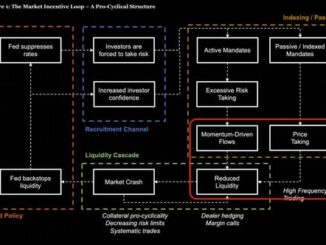
ENB Pub Note: This is a fantastic article from Irina Slav’s Substack, and we recommend you subscribe and support her channel! She is spot on, and the United States has a plan and a path for Energy Dominance that is the envy of the world energy markets. We will be covering this on our podcast.
Language, we were taught at university, is constantly evolving, constantly in flux, as speakers attach new meanings to existing words and phrases to reflect a reality equally in flux or invent new words and phrases in response to new phenomena.
Narratives, being made up of words, are also constantly evolving and nowhere is this more evident than in the climate change narrative. The climate narrative has demonstrated remarkable flexibility, especially in recent months, as its material foundations, never particularly sturdy to begin with, started crumbling at accelerated rates.
One fresh example comes from the United States, where the wind and solar industries are in disarray following the Trump administration’s offensive against weather-dependent, intermittent energy generation that also destroys wildlife.
The tune that wind and solar are better for the planet and the climate, whatever that means, has been exhausted, so the singers are changing it. Now, focus is on energy security in the age of data centres.
From the FT: “Donald Trump’s attacks on renewable energy have thrown the sector into chaos, prompting industry concerns that the US will struggle to meet surging demand to power the artificial intelligence revolution.”
The industry being concerned is not really Big Tech, although it has thrown its weight behind windosolar’s worry about the future, possibly in a knee-jerk reflex seeking to protect their virtuously green reputation. The industry being concerned is in fact the two industries that have seen their stocks plunge and many of them declare bankruptcy because of the end of subsidies.
Windosolar began making their case for data centre electricity supply even before Trump took office. Sadly, it didn’t work because Trump picked an actual energy industry insider to lead his Department of Energy — a move, I might add, that has earned the entire population of the U.S. my eternal envy.
Under Chris Wright, the U.S. is betting on baseload generation. Not that this has stopped windosolar from singing their new song. Here’s the lyrics as summed up by a climate activist with a job title of “climate + infrastructure finance analyst”.
From the FT piece: ““Renewables can be built and connected in a matter of a year or two, in a way that meets data centre developers’ timelines,” said Advait Arun, an energy policy analyst at the Center for Public Interest. “If you’re ignoring renewables, then you’re missing a key part of the equation.””
It is quite true that wind and solar can be built and connected much faster than, say, a standard nuclear power plant. It is equally true that they cannot generate baseload electricity the way a standard nuclear power plant can. And if you’re ignoring the baseload factor, I dare say you’re missing a key part of the equation. Which is, of course, a characteristic of the whole transition narrative, commonly referred to by naggers such as myself as cherry-picking.
Yet this sort of spin is child’s play compared to what European activists are capable of these days. Here’s a recent story in Euractiv, penned by a lady who is “CEO of the We Mean Business Coalition of seven leading non-profit sustainability organisations. She is expert in sustainable development, energy and climate action, with more than 25 years’ experience in business, government and NGOs.” She also happens to be a WEF functionary and a board member of the Science Based Targets initiative. In a word, a pro.
The story is about this year’s wildfire season that, per Maria Mendiluce, showed “a striking display of European solidarity – a supranational force activated swiftly across borders, delivering tangible support at speed,” because lots of firefighters were sent to Spain to put out the wildfires under the EU Civil Protection Mechanism. No one sent firefighters with anything like that scale or speed to help with our wildfires, I’d like to note, with EU authorities contenting themselves with just sending over a couple of small planes that didn’t do a lot, but I guess we should know our place and be grateful for whatever we got.
Anyway, while the firefighters fought the Spanish fires, the county’s PM had a brilliant idea: “A call to depoliticise the climate emergency and build a national framework for action rooted in science, not party platforms,” per Mendiluce.
Here we have the standard operating procedure of picking only the worm-infected cherries, namely the implication that there were no wildfires before we started using hydrocarbons and we need to make them go away — including by building, yes, more wind and solar. Because panels and turbine columns don’t burn, I expect. The climate narrative is now shifting from “Save the planet” to “Let’s get more resilient,” reflecting normal people’s doubts about the whole transition thing and whether it might not be a good idea to adapt, as nature intended.
Here’s the narrative flux on full display in a single short paragraph: “The infrastructure needed for decarbonisation is also needed for resilience. Local solar, smart grids, decentralised storage, demand flexibility: these are tools for both emissions reduction and climate response. The policy files may differ, but the outcome – energy systems that survive a crisis and cut emissions – is the same.” Told you. Panels and columns don’t burn, not to mention turbines. Also, “climate response” sounds really responsible and authoritative. The bottom line: centralisation.
That’s right, the narrative evolves but the end goal remains the same — concentrating as much power as possible in as few hands as possible, masking it as “consistency and coordination”. Here’s the whole quote because I feel the acid reflux coming just reading it.
The governance structures that evolved for deliberation and dissent must now accommodate consistency and coordination. That will mean new institutional tools: cross-party climate frameworks, legislative safeguards for long-term plans, stronger alignment between regional, national and EU levels. In some countries, it may also mean constitutional commitments – climate as a shared mandate.
I have to admit it’s a rather clever way to counter the rising anti-totalitarian tide across Europe, which incumbents like to call a far-right wave. If you can’t beat them, make them join you. Too bad the assumptions underlying this new form of centralisation pressure are fraying faster and faster. The science is not settled. People do not want to pay for a massively expensive transition. And they don’t want solar all over the place. Good luck to the narrative pushers.
Avoid Paying Taxes in 2025
Crude Oil, LNG, Jet Fuel price quote
ENB Top News
ENB
Energy Dashboard
ENB Podcast
ENB Substack






